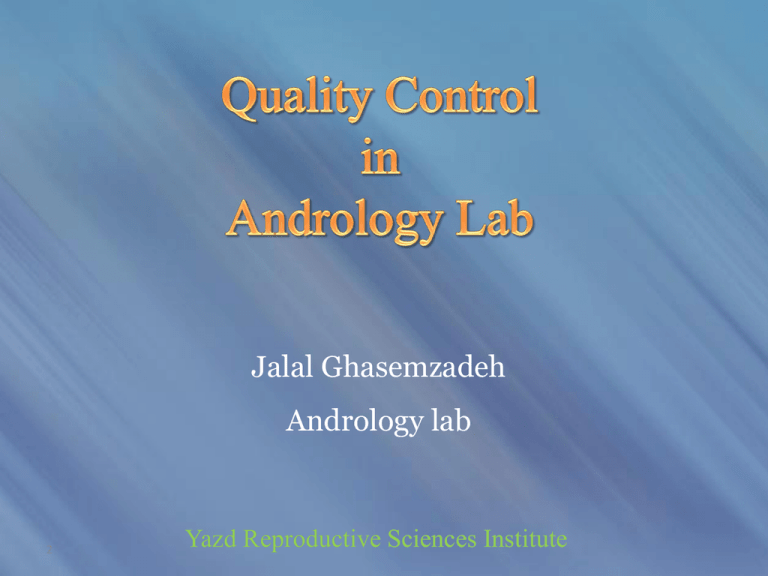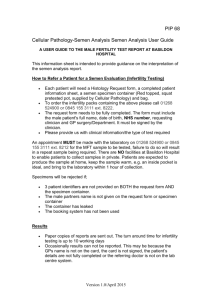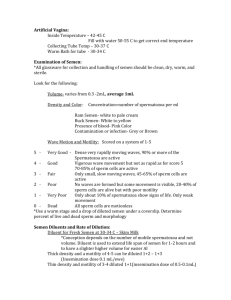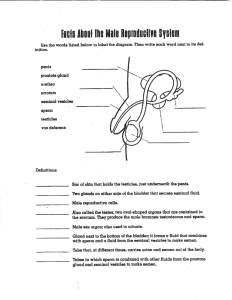and quality control
advertisement

Jalal Ghasemzadeh Andrology lab 2 Yazd Reproductive Sciences Institute 2 Quality assurance (QA) and quality control (QC) are essential aspects of any laboratory testing process. Quality Assurance An overall management plan to guarantee the integrity of data. Quality Control A series of analytical measurements used to assess the quality of the data. Early editions of the World Health Organization (WHO) Laboratory Manual almost no reference to the need for QA or QC as a part of semen analysis. Yet, a subsequent series of publications made the observation that significant disagreement could occur between analysing laboratories, hence highlighting the need for improved QA and QC. It was, therefore, a significant step forward when the 4th edition of the WHO manual published detailed guidelines for QA and QC of semen analysis for the first time. Andrology laboratories need to produce reliable results for appropriate diagnostic and health care decisions. Since semen analysis is highly complex and procedurally difficult to standardize, quality control (QC) is essential to detect and correct systematic errors and high variability of results. The large discrepancies between assessments of sperm concentration and morphology in different laboratories underline the need for improved QC and standardization. 5 Whatever its size, each laboratory should implement a quality assurance (QA) programme, based on standardized methods and procedures, to ensure that results are both accurate and precise. The fundamental parameters of sperm concentration, morphology and motility should always be monitored by internal quality control and, where possible, by external quality control. 6 The management of QC procedures requires an understanding of the source and magnitude of measurement errors. Any measurement has a degree of error, the magnitude of which is described by a confidence interval with an upper and a lower limit. A precise measurement is one in which the limits lie close together; a result is accurate when it is close to the true value. 7 There are two classes of error: random and systematic. Random errors, which affect precision, arise from chance differences in readings or sampling, and can be assessed from repeated measurements by the same observer and equipment. Systematic errors (sometimes referred to as bias) are more insidious, since they arise from factors that alter the result in one direction only, and thus cannot be detected from repeated measurements. 8 Even when the sample is well mixed, the random distribution of spermatozoa in semen, or in fixative or medium, accounts for much of the lack of precision of the results of semen analysis. The assessment of sperm concentration, motility, vitality and morphology involves counting a limited number of spermatozoa, which are presumed to be representative of the whole sample. 9 The aim of quality control in routine semen analysis is to monitor the extent of both random and systematic errors and reduce it where possible. A QA programme monitors and evaluates, on a regular basis, the quality and appropriateness of the data and services that the laboratory provides. The QA programme should be described in a quality manual (QM) containing standard operating procedures (SOPs) and a detailed set of instructions for the different processes and methods used in the laboratory. 10 The QM describes the organizational structure of the laboratory, listing the required skills (training) needed in different positions (job descriptions), as well as schedules for meetings between testing personnel and supervisors, and plans for continuous education, development and training of staff. 11 The written SOPs should be strictly followed by all laboratory technicians. These protocols include referral notes, patient information procedures, schedules of patient appointments, performance of assays, reporting of analytical results, training of new laboratory staff members, testing and monitoring of equipment, , such as microscopes, centrifuges, pipettes, balances, freezers, refrigerators and emergency equipment 12 There are three areas in which the revisions will have an obvious and immediate impact: (i) the measurement of semen volume to facilitate the calculation of total sperm number per ejaculate; (ii) the measurement of sperm motility; and (iii) the measurement of sperm morphology. 13 To date, the significance of measuring semen volume has probably been under-recognized by scientists and has not been given adequate thought with regard to QA and QC. However, the recognition that total sperm number per ejaculate may be a better predictor of pregnancy than sperm concentration (numbers per unit volume) implies that it should now be taken more seriously. However, the 5th edition recommends that it is preferable to infer volume from the sample weight, because the specific density of semen is sufficiently close to that of water(at 1 g per mL). To date, sperm motility has been reported by classifying spermatozoa into one of four movement patterns (a to d) and reporting the proportion of spermatozoa in each group as a percentage of the whole number observed. The four-grade system was underpinned by observations that only sperm with specific motility patterns were able to penetrate the cervical mucus (and therefore enter the female reproductive tract). 15 Despite this background, the 5th edition of the WHO manual proposes a simplified classification system to include only the following three grades: (i) progressively motile (PM); (ii) non-progressively motile (NP); (iii) immotile (IM). This system is based on the argument that laboratory scientists cannot accurately define whether sperm are moving at above or below 25 μm per second. 16 Perhaps a better question is to ask why, 20 years after CASA machines became available commercially, is this technology not more widely used by andrology laboratories for the measurement of sperm motility? There are several reasons: they can be expensive, they have their limitations, they require careful set-up. 17 18 19 The andrology laboratory should provide adequate space for the levels of equipment and activity within it. The laboratory should be secure and should be designed to minimise traffic in work areas. Back up power supplies should be provided for all critical items of equipment, including incubators, freezers and monitoring equipment. Floors, walls and ceilings must have non porous surfaces that can be cleaned easily. There should be clear separation between disciplines and between laboratory and office areas. Attention should be paid to general working conditions, such as 20 bench and seating height, air conditioning and lighting Specimen production/collection areas should be designed and equipped with careful consideration to the following: a. The clutter free and safe decontamination b. The safe delivery of samples c. The comfort, privacy, security and safety of patients d. The security and safety of staff e. Access for disabled persons 21 Processing of sperm for cryopreservation must take place in a separate designated clean area and in a class II or laminar flow cabinet. Storage of frozen cells and tissues should be carried out in a separate designated secure and safe facility. Risk assessments should be carried out with respect to the following: There must be low level extraction and air flow through the room which is adequate for the volume of nitrogen stored. In the event of significant spillage, emergency procedures must be in place to deal with nitrogen hazards e.g. burns and asphyxiation and allow the increased volume of gas generated to escape. The storage room must have an oxygen depletion monitor, linked to an external warning system. The oxygen detection cell must be regularly replaced in accordance with manufacturers instruction. 22 Human body fluids, such as semen, are potentially infectious and should be handled and disposed of with special care. For the andrology laboratory, the most important infectious microorganisms that may be found in semen are HIV and hepatitis B and C viruses (HBV and HCV). 23 All laboratory personnel who work with human samples should be immunized against hepatitis B. No-one should eat, drink, smoke, apply cosmetics or store food in the andrology laboratory. Pipetting by mouth should not be permitted. Mechanical pipetting devices should always be used for the manipulation of liquids. All laboratory staff should wear a laboratory coat or disposable gown in the laboratory and remove it upon leaving. Laboratory personnel should wear disposable gloves (rubber, latex or vinyl, with or without powder), especially when handling fresh or frozen semen or seminal plasma or other biological samples and any containers that have come into contact with them. Gloves must be removed and discarded when staff leave the laboratory or use the telephone or computer. They must not be reused. 25 Personnel should wash their hands regularly, especially before leaving the laboratory, after handling specimens and after removing gowns and gloves. Staff should take precautions to prevent accidental wounds from sharp instruments that may be contaminated with semen, and avoid contact of semen with open skin, cuts, abrasions or lesions. 26 All sharp objects (needles, blades, etc.) should be placed in a marked container after use. This container should be sealed before it becomes full and disposed of in the same way as other dangerous laboratory items. Staff should wear protective safety goggles, insulated gloves and closed shoes when necessary, e.g. when using liquid nitrogen. 27 Wash the work space with disinfectant, e.g. sodium hypochlorite 0.1% (1 g/l) or similar disinfectant, wait at least 1 hour (or overnight), then rinse off disinfectant with water. 28 Yazd Reproductive Sciences Institute






